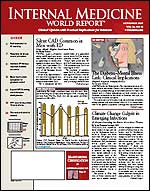Expand MRSA Testing to Include the Skin and the Anterior Nares
By Sarah Pressman Lovinger, MD
Staphylococcus aureus
CHICAGO—Testing both the anterior nares and the skin provides the most accurate assessment of methicillin-resistant (MRSA) colonization in long-term care patients, presenters said at the Interscience Conference on Antimicrobial Agents and Chemotherapy. However, MRSA colonization patterns could differ in the community and in the hospital.
The 2 major strains of community-associated MRSA identified in this country are USA300 and USA400.
Currently, most active surveillance for the USA300 MRSA strain relies on nares culture. However, swabbing only the nasal passages of long-term care patients will miss MRSA colonization in some patients.
"To get full coverage of USA300, patients should be tested for colonization of the nares and skin," said lead investigator Simone Shurland, MS, of the University of Maryland, Baltimore.
Ms Shurland and colleagues at the University of Maryland and the Veterans Administration Maryland Health Care System performed a prospective observational study of 227 extended-care patients in these 2 institutions. All participants had MRSA colonization documented within the past year. Cultures of the anterior nares, perineum, axilla, and any areas of skin breakdown were obtained weekly for 3 weeks. Participants who had positive cultures of the nares or of any of the skin sites tested were considered to be colonized with USA300 MRSA.
The participants were mostly men and mostly white; mean age was 65 years. Information on length of stay, previous use of antibiotics, and comorbidities was not provided.
In those who were colonized with USA300 MRSA, 82% had a positive nares culture, and 61% had a positive skin culture.
Although they only studied patients in Baltimore, the investigators postulated that since MRSA300 is widespread in the United States, their results are likely to apply to patients in long-term care facilities in other regions. However, colonization patterns could be different in the community and in hospitalized patients.
These results indicate that surveillance of both the skin and the nares provides more complete information on MRSA colonization in long-term care facilities and could help physicians identify more patients who might be carrying this pathogen.
Although it is a common practice, performing surveillance cultures remains controversial. It is not clear that surveying for MRSA in this way decreases MRSA infections in hospitals and in other healthcare facilities.
The investigators of this study wanted to determine which surveillance culture sites might be useful, noting, "If surveillance cultures decrease MRSA transmission or MRSA infections, then the same surveillance culture sites can be used to detect USA300 MRSA as other types of MRSA."
